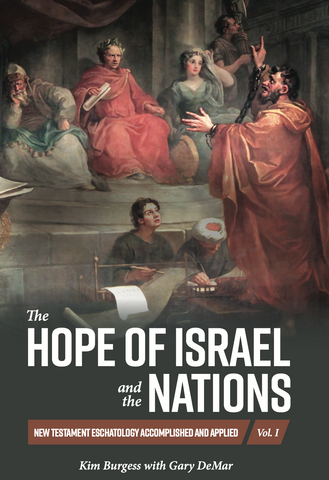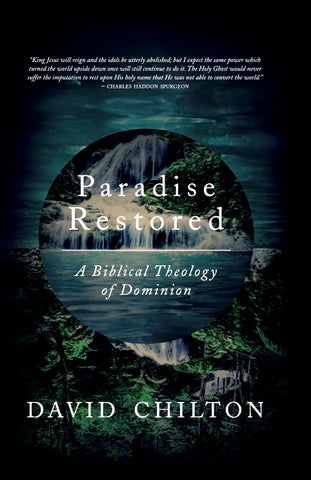A few years ago, I spoke at a conference on postmillennialism in Torrance, California, on the topic, “Evidence that Postmillennialists are Winning the Prophecy Debate.” I only got through a small portion of what I prepared. Ken Gentry also spoke. Kirk Cameron was there at my invitation. He gave a great talk about his prophetic pilgrimage. Sorry to say, the recording of my talk did not turn out. This is why I bring my own recording devices.
While waiting at the airport to board the redeye back to Atlanta, I came across the following post on Facebook: “Prof. D. J. Engelsma gives a devastating rebuke to the Postmil notion of ‘Christianizing the world.’” The poster asked for comments. Here was my first comment: “David Engelsma is fixated on the common grace argument. That’s a Christian Reformed Church amillennial problem. Engelsma uses almost no Scripture. His eschatology is closer to dispensationalism.”
I later added this comment, and for this article I’ve added more from Gary North:
The Common Grace amils that Engelsma condemns share his prophetic position: “These common grace Dutch scholars and their North American academic disciples have all been amillennialists. As amillennialists, they believe that Satan’s earthly kingdom and influence will expand over time until Jesus comes with His angels in final judgment. This assertion of the cumulative, visible triumph of Satan’s kingdom in history is inherent in all amillennialism. This view of New Testament era history defines amillennialism. Amillennialism, as with premillennialism’s view of everything that takes place prior to the millennium, is essentially a reversed form of postmillennialism: postmillennialism for Satan’s kingdom.”[1] (Gary North, Millennialism and Social Theory, 82). This is Engelsma’s position as well.
Typically, Englesma spends more time on the creeds and confessions than he does on Scripture. Instead of offering a detailed counter exegesis to a preterist interpretation of Matthew 24, he assumes, like dispensationalists, that it is a prophetic description of end-time events: “This interpretation of Matthew 24 is basic to the postmillennial denial of apostasy, Antichrist, and great tribulation for the church in the future,” he writes. “For in the light of this explanation of Matthew 24, the postmillennialist goes through the entire New Testament rigorously applying all prediction of such things to the destruction of Jerusalem.” When a prophetic passage is about a soon coming judgment, then yes, the AD 70 destruction of Jerusalem is in view, and Prof. Engelsma doesn’t give any exegetical evidence to the contrary. He also seems to be unaware of the biblical definition of antichrist (2 John 7), their number, and when they were alive (1 John 2:18, 22).

The Hope of Israel and the Nations
The reader and student of the Bible must first understand the content of the New Testament writings in terms of how those in the first century would have understood it. The New Testament is written against the background of the Old Testament. The shadows of the Old were fulfilled in the reality of the New. All the rituals and ceremonies were fulfilled in Jesus. The same is true of the temple, land, blood sacrifices, the nature of redemption, the resurrection of the dead, the breaking down of the dividing wall dividing Jews and Gentiles, and so much more. The New Testament's emphasis is on the finished work of Jesus and its application, not only to that Apostolic generation but to the world today.
Buy NowWhile creeds and confessions are important, they are not equal to Scripture, and in terms of eschatology, say very little. The Westminster Confession of Faith Chapter 31 says as much:
III. All synods or councils, since the apostles’ times, whether general or particular, may err; and many have erred. Therefore they are not to be made the rule of faith, or practice; but to be used as a help in both.
In fact, the WCF was changed on an eschatological issue: the antichrist. The original WCF identified the papacy as the antichrist. Here is the original version from Chapter 25:
VI. There is no other head of the Church but the Lord Jesus Christ. Nor can the Pope of Rome, in any sense, be head thereof; but is that Antichrist, that man of sin, and son of perdition, that exalts himself, in the Church, against Christ and all that is called God.
Here’s the American revised version:
- There is no other head of the church but the Lord Jesus Christ. Nor can the pope of Rome, in any sense, be head thereof.
Prof. Engelsma is fond of quoting confessional statements while giving little regard to biblical exegesis in his article “Jewish Dreams” that appeared in the January 15, 1995 issue of The Standard Bearer. Have we become Romanists?
Recently, an article has appeared in the theological journal Themelios with the title “Postmillennialism: A Biblical Critique”[2] written by Jeremy Sexton. The following is the conclusion to his critique.
In view of the exegetical implausibility, theological shortcomings, and spiritual hazards of postmillennialism, believers should eschew “Jewish dreams that there will be a golden age on earth before the Day of Judgment” (Second Helvetic Confession XI) and keep a lookout for Christ’s imminent [3] second coming (Matt 24:36-25:13; Luke 12:40; Rom 13:12; Jas 5:8; 1 Pet 4:7; 2 Pet 3:12; 1 John 2:18; Rev 1:1, 3; 2:16; 3:11; 22:6-7, 10, 12, 20), knowing that our eschatological “salvation” is ever “ready to be revealed” (1 Pet 1:5). Triumphalist expectations about what must transpire on earth before Jesus comes back diminish the comfort and motivation to godliness that stem from loving and anticipating his near return (Mark 13:32-37; Phil 3:20; 4:5; 1 Thess 1:10; 4:15-18; 5:6-11; 2 Tim 4:8; Titus 2:11-13; Heb 10:24-25; Jas 5:9; 2 Pet 3:10-12; 1 John 3:2-3). As long as the Father continues to delay (Matt 24:48; 25:5, 19; 2 Pet 3:4) the paradoxically fixed day of the parousia (Matt 24:36; Acts 1:7; 17:31) to allow more time for repentance (2 Pet 3:8-9) and to complete the divinely preset amount of suffering and martyrdom assigned to the church (Col 1:24; Rev 6:11), we must hasten that final day by living godly lives (2 Pet 3:11-12).[4] And we must use the borrowed time to deepen and widen the victory of the Great Commission achieved by the apostles, eagerly anticipating the redemption of our bodies and continually praying, “Come, Lord Jesus!” (Rev 22:20; cf. 1 Cor 16:22; Westminster Confession of Faith XXXIII.III).
I did not want to spend time evaluating Sexton’s article. I’ll leave that task to others. Most of the objections have been answered elsewhere. When I read the author’s conclusion, I was immediately struck by how off-base he was. It’s as if he has not done much study of preterist arguments. He mentions Douglas Wilson on Revelation 19 and adds a footnote from Peter J. Leithart’s massive two-volume commentary on Revelation.[5] It’s because of his failure to tackle preterist interpretations of Bible prophecy that his critique can only be two legs of a three-legged stool. Timing is everything. Let’s begin with 1 Peter 1:5 where we find “the salvation ready to be revealed in the last time.” Ready for whom? For Peter’s intended audience. What last time? In 1 Peter 4:7 we read, “the end of all things has drawn near [perfect indicative active].” Near for whom? For the recipients of Peter’s letter. Note what follows 1 Peter 1:5:
In this you greatly rejoice, even though now for a little while, if necessary, you have been distressed by various trials, so that the proof of your faith, being more precious than gold which perishes though tested by fire, may be found to result in praise, glory, and honor at the revelation of Jesus Christ (vv.6-8).
“A little while” is not sometime in the ongoing distant future.

Paradise Restored
Plowing through the often-difficult terrain of Soteriology, Eschatology, and Hermeneutics, David Chilton presents a simple and coherent vision for Gospel fruitfulness, Gospel effectiveness, and eventually, Gospel victory.
Buy NowI don’t like the term “postmillennialism” because the moniker depends too much on the millennial language from Revelation 20, specifically, the “one thousand years.” Before there can be a discussion of the “millennium” (I prefer the biblical language of “kingdom”: Mark 1:15; Acts 28:23, 31; Rev. 1:9), the topic of preterism must be dealt with. Unfortunately, Sexton does not offer a studied evaluation of at least some aspects of preterism, and yet the future of eschatological studies depends on a deep dive into preterism.
Gary North got it right. What we have today is “postmillennialism for Satan’s kingdom.” Professor Richard Gaffin said: “The church wins by losing.” In a similar vein, John MacArthur said the following:
“Oh, guess what? We don’t win down here. We lose. You ready for that? Oh…oh, you were a postmillennialist? You just thought we were going to go waltzing into the Kingdom as you took over the world? No. We lose here,” MacArthur said. “We lose on this battlefield. But we win on the big one, the eternal one.”
“Waltzing into the Kingdom” and taking “over the world” do not define biblical kingdom theology (AKA postmillennialism). Applying the reality of the kingdom takes hard work and the belief that Jesus redemptive work makes it all possible. That’s why Kim Burgess and I decided to tackle the application of Jesus’ kingdom work in the first volume of The Hope of Israel and the Nations: Biblical Eschatology Accomplished and Applied.
[1] Gary North, Political Polytheism: The Myth of Pluralism (Tyler, TX: Institute for Christian Economics, 1989), 139.
[2] Volume 48, Issue 3 (December 2023): https://www.thegospelcoalition.org/themelios/article/postmillennialism-a-biblical-critique/
[3] “QUESTION. ‘Should not the speedy coming of the Lord be anticipated at all times, or as “possible at any time; that no generation of believers should regard it as impossible in theirs,” as Archbishop Trench avers?’
“ANSWER. Where in the Scriptures is the second coming of the Lord represented as continually imminent, so that it may occur at any moment? It was imminent before A. D. 70, but that does not make it always imminent. If it was imminent then, it is not imminent now. If the expressions and phrases which assert its nearness were true then, they are not true now; and if they are true now, they were not true then. This demonstrates the error of all believers in the future sudden appearance of our Lord, in using terms and phrases to prove its present imminence, after the lapse of more than eighteen centuries, which, when employed by our Lord and his apostles, did teach the imminence of his coming. The words ‘quickly,’ ‘at hand,’ ‘in a little while,’ etc., mean soon or they do not. If they do, then, as God is faithful, the event came to pass long ago. If they do not, then they are of no possible value to prove it near today. What was true for the apostles may not be true for us. What was applicable to their case may have no application whatever to ours. Good ‘ethical’ effects can flow only from the truth. It cannot benefit one to believe that the second coming of the Lord is imminent unless in fact it is. Nothing has caused more skepticism than this very insistence on the near approach of the parousia, and the reiterated failure of such prophecies. The infidelity and loss of respect for the Bible on the part of many of the followers of William Miller, when they found that his calculations were fallacious, were fearful. Time after time has been set, only to pass without the event occurring. A Boston paper admitted, years ago, that ten times it had fixed the time for the Lord’s coming, and as many times was, of course, disappointed. What can such a course produce in many minds but despondency, and then utter incredulity?” 179-180.
[4] Richard J. Bauckham, “The Delay of the Parousia,” TynBul 31 (1980): 3-36; David L. Mathewson, Where Is the Promise of His Coming? The Delay of the Parousia in the New Testament (Eugene, OR: Cascade, 2018); Thomas R. Schreiner, 1, 2 Peter, Jude, NAC 37 (Nashville: B&H, 2003), 389-391.
[5] Peter J. Leithart, Revelation 12-22, ITC (New York: T&T Clark, 2018), 269–298.

